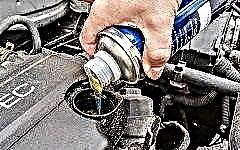

The content of the article:
- Do you need additives
- Groups and types of additives for engine oil
- Application methods
- Flaws
Additives (additives) for engine oil are special means for increasing the antiwear and performance characteristics of the engine, as well as for micro-repair of surfaces of already worn elements. In addition, additives are capable of acting as a sealant and plugging microleaks in a heavily worn out engine.
Do you need additives

Manufacturers of additives often refer to their products as “tribo-composition” (protective and reducing agent). And the word "additive" is the popular name for the tribo composition.
There are many skeptics on the issue of engine oil additives who argue that these formulations are not needed at all. At the same time, they present a simple argument: "the engine oil already has everything necessary for the normal operation of the engine." And this argument is, in principle, correct, but with one important clarification: "for normal operation." But how often do the engines "work normally", without increased or critical loads (especially in cities with numerous traffic jams)?
The question is rhetorical, since the answer to it is quite obvious - "normal operation" of the engine does not always happen (rather, on the contrary - more often "abnormal"), and not only because of traffic jams, but also because of severe weather conditions, poor fuel or oil, faulty ignition and timing systems, untimely maintenance, etc.
If we use medical terms, then in the recent past, motor additives were treated as "energetic", which increased the tone and performance of the "senile" engine.
Today, the attitude towards additives has changed, and they are already considered not only as an "energetic", but also as a "prophylactic agent" for increasing the protective properties of engines during daily operation and extreme loads.
However, when using engine additives, it is important to know and understand what properties they have and how safe, useful (or useless) they are for the "heart" of the car.
Groups and types of additives for engine oil

They can be divided into two main groups:
- Factory (for industrial production).
- Individual (for private, independent use by car owners or car services).
Factory additives
In general, engine oil consists of two parts: base oil and additives. That is, oil manufacturers simply take the base oil and add a package (set) of additives to it. Therefore, all modern factory commercial oils (sold in stores) for automobile engines already contain these compounds, the total content of which can reach up to 25%.
Depending on the properties and purpose, factory additives are divided into several types:
- Viscous (thickeners).
- Washing (detergent).
- Detergents (dispersant).
- Antioxidant (oxidative).
- Anti-corrosion.
- Antiwear.
- Antiparaffin (depressor).
- Anti-foam.
- Anti-seize.
- Friction modifiers.
It is important to know that factory additives cannot be selected and bought in a regular store, as they are intended for factories that produce engine oils on an industrial scale... At the same time, the production technology and chemical composition of additives from different manufacturers, as a rule, differ and are classified. In the public domain, there is only general information about some components and properties of the product.
Individual additives (for independent use)
It is easy to guess that the use of individual additives will require an individual approach. And each type of these formulations should be used only for a specific purpose and for a specific engine, taking into account its condition.
Individual additives are divided into four main types:
- Break-in - are used for the initial running-in of engines, both new and after overhaul. The use of break-in additives speeds up the break-in process and makes the grinding of new rubbing parts better.
- To reduce friction... Such compositions additionally reduce the frictional force between rubbing parts. As a result, not only the wear of rubbing parts is reduced, but also the efficiency of the engine increases. Accordingly, such additives are useful for preventive purposes for any engines, except for new ones and after major repairs (with a mileage of less than 2,500 thousand km).
- Restorative - they "restore" the worn-out surfaces of the elements, increasing micro-dents, which can significantly delay the overhaul time for a heavily worn-out engine. In addition, the use of such additives reduces oil consumption. Accordingly, such substances are relevant for old and heavily worn engines.
- Detergents (cleansing) - are used to clean the engine from various deposits: hydrocarbon (carbonic), soft resin and other "varnish deposits", coke "crusts" on the intake valves and carbon deposits in other places of the engine accessible to oil.
Additionally, additives for motor oils are divided into three types, according to their chemical composition:
- Based on mineral powders... For example, layered friction modifiers (with graphite, sulfide silver, disulfide molybdenum, boron nitride, disulfide tungsten) and geomodifiers (fullerenes). The listed products have not only antiwear, but also cleaning properties. When using mineral powder additives, special attention should be paid to their compatibility with the engine oil.
- Based on metal-cladding elements (remetallizers)... They contain ions of soft metals, due to which a thin protective layer (cladding film) is formed on the rubbing surfaces of parts.
- With polymer additives... They are also used to increase the wear resistance of rubbing surfaces. When a certain temperature and pressure is reached inside the engine, a protective Teflon layer with a low coefficient of friction is formed from polymer additives.
How to apply engine oil additives

Before using them, you need to decide on the following information:
- For what specific purpose is the additive planned to be used.
- What is the selected composition intended for, and what properties it has.
- What kind of oil is used in the engine where the additive is planned to be used (synthetic, semi-synthetic or mineral).
- What oil is the additive compatible with?
- Complete and reliable information (preferably) about the manufacturer of the selected fluid.
As a rule, the specific method of application (dosage, frequency, etc.) is indicated by the manufacturer in the "Instructions for use" of the product, which must be strictly observed.
For different manufacturers of additives, the methods of application may differ: for someone it should be added in several stages, for someone the substance is simply added to the oil, etc.
It should be remembered that if the additive is incompatible with engine oil, a dense film similar to a rubber layer may form on the surface. To remove such a layer, you will have to completely replace the oil and flush the entire engine.
In some cases, an incompatible additive can turn the oil into a gelatinous mass, which will clog the oil lines., as a result of which the engine will have to be completely disassembled.Therefore, the issue of compatibility of such a composition with oil is of paramount importance, especially when using substances based on mineral powders.
If the use of an additive involves pouring it into oil already used in the engine, then before adding it, you must make sure that the oil in the engine is fresh. If it has already worked 1,000 km or more, then the desired result will not be achieved. In the best case, stale oil with an additive will leave deposits on the piston, 70% more than usual, at worst - will lead to increased wear of parts and overheating of the engine with irreversible consequences.
The fact is that stale waste oil, unlike fresh oil, loses its absorbency and cannot dissolve the additive components in itself. The best time to use the additive is a complete oil change with an oil filter. The use of additives is especially important when using low-quality oils.
The expediency of using a particular fluid should be determined by the initial state of the engine. For new and not very worn out motors, it is advisable to use geomodifier compositions, which increase the characteristics of the engine and increase its resource. In addition, geo-modifying additives are used on the “fill and forget” principle, without constant reapplication. But "senile" and heavily worn out engines will need a more potent agent (metal-cladding or polymer), with lifelong use. This, of course, will not save the engine from overhaul, but it will significantly delay it, reduce oil consumption and reduce the likelihood of unexpected engine failure.
Disadvantages

In addition to the positive effect, the use of additives also has some disadvantages:
- Powder-based additives with layered friction modifiers create a coating that needs constant replenishment of active ingredients... That is, reapplication of the fluid is required when changing the oil. In addition, these additives promote the formation of deposits and are prone to corrosive degradation.
- Remetallizing additives, like the previous compositions, create protective (cladding) coating only at a constant concentration of the agent... That is, after changing the oil, the low-adhesion cladding layer is quickly worn out. Therefore, when changing the oil, it is necessary to reapply the metal-cladding (remetallizing) additive.
- Polymer additives help formation of "lacquer deposits", clogging of channels and an increase in harmful substances in the exhaust gases.
Conclusion
As practice has shown, the use of additives for motor oils really gives a positive effect. And all negative reviews about these substances, as a rule, are based either on improper use of additives, or on the use of low-quality fakes that are useless and sometimes harmful.
Therefore, it is necessary to choose additives carefully and responsibly, from trusted manufacturers and preferably on a recommendation. Experiments on the principle "it will work, it will not work, it does not matter" are inappropriate in this matter!











